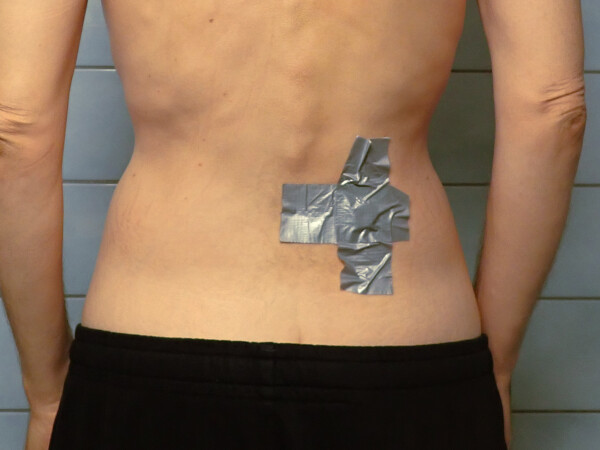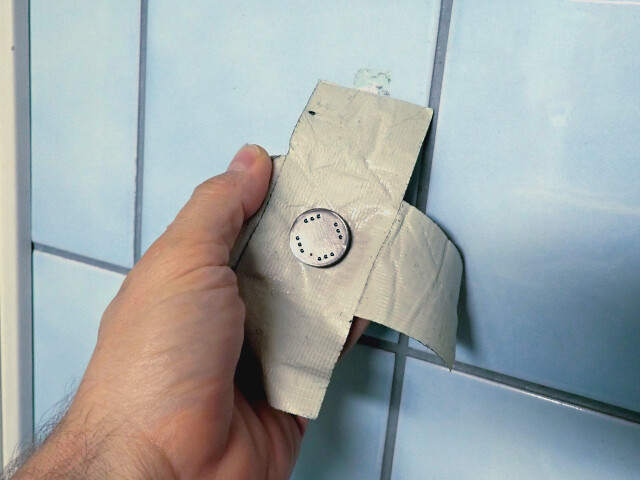The thing is with UHF tags and to an extent HF tags they are never platform independent as I’m sure you know. An NFC tag in ‘air’ resonant at 13.56MHz will generally shift upwards a couple of MHz when placed on the skin and even more when placed under the skin. Implanting an ‘air’ designed tag is not really the best thing for optimum performance. The thing becomes a headache at UHF, you optimise a design for one person and it won’t fit all. Build and even ethnicity screws things up. For a small optimised UHF antenna mounted upon the palate of the mouth you’ll get about 0.8m read-range when everything is aligned and with a good reader. If you’re in the states then you might get a bit more as you’ve double the power of what we’ve got in Europe. Here’s a short conference paper Small Epidermal UHF RFID Loop Antenna for Passive Oral Cavity Control Applications and Patient Health Monitoring - Kent Academic Repository . It was just to see if we could get some RF out the mouth! It has since progressed to a mouth mounted sodium measuring tag ![]()
Similarly for finger mounted ring type UHF tags you are looking at a 2 - 5m read-range dependent on substrate height from the finger. Coincidentally details are here ![]() Finger Worn UHF Far Field RFID Tag Antenna - Kent Academic Repository
Finger Worn UHF Far Field RFID Tag Antenna - Kent Academic Repository
Really interesting papers. Thank you for sharing! Also, I finally meet someone who seems to have a job as cool as mine ![]()
Re UHF performances under the skin, I’m nowhere near the specialist you are on the subject, but two simple facts seem quite clear: the higher the frequency, and the more you work in the far field, the more attenuation you get if the transponder is near or behind wet ionized meat. This is even quite obvious with NFC tags: HF implant performances are rather pathetic compared to similar sized LF implants in-situ.
I’m actually surprised you got 0.8 m out of a UHF transponder on the palate - which essentially means the antenna is surrounded by 2" of flesh in all directions.
As for the mouth being a hostile RF environment, as described in your first paper, it’s only true if you try to go through it. But here’s a fun trick I use all the time: open your mouth, put your car’s remote inside it, face your car, and you’ll be able to unlock it from a lot further away. Those remotes work at 433 MHz, so your open mouth becomes a resonant cavity.
Anyway, apart from performance issues, the other practical factor that made me give up the UHF implant idea is that the working frequencies in Europe and in the US are different. That means if I want to buy hardware from outside Europe, there’s a 50-50 chance I’ll get something with the wrong frequency, or that it won’t be offered with the European frequency. I can foresee right now that it’ll get frustrating in a hurry - especially considering the price of that hardware.
Care to elaborate? I’m curious to know what you mean by that.
I think you might mean UHF here… because our experience has been that 13.56MHz magnetic coupling only detunes by about 1kHz to 2kHz only.
agree, thanks for sharing!
Ha ha, thanks, I’m not so sure about the cool bit though. People after many years still say to me “now what is it you actually do?” Even family!
Yes it’s interesting coupling your fob to the body or road furniture to see the range improvement, even though things are unlikely to be matched in anyway…unless you’re lucky.
This is useful multi-region development kit which I use. Depending on what you want/need to spend. It has some basic software and an SDK.
https://www.digikey.co.uk/product-detail/en/thingmagic-a-jadak-brand/M6E-DEVKIT/1523-1006-ND/4842690?cur=GBP&lang=en
This is for patient health monitoring of sodium intake based on this rather old device…… ams SL900A EPC Gen2 Sensor Tag Sensor Interfaces | ams OSRAM
I wish it was only a few MHz at UHF Amal but unfortunately that has been my experience at HF, both in simulation using CST Microwave Studio and practical on/off body measurements. But I’ve never practically measured an implanted tag…yet ![]() Out of interest I wonder what your measurement technique is?
Out of interest I wonder what your measurement technique is?
A basic SDR vector network analyzer with coupler. The tuning adjustments we make to out antennas only require ~ 2khz bump to maximize peak.
“antennas”
Amal gives the megahurtzmeter dial a tap, needle jumps to the other side of the scale
“Uh oh…”
Don’t know if you solved the loud buzzer problem or not, but if that truly is a line out, you could just try putting a 3.5mm jack in there that’s not connected to anything. That usually shuts off the onboard audio ![]()
No can do. The line out is not connected to anything. I just filled up the buzzer with epoxy glue.
My installer comes on Saturday, and this time I’m going through with the backside flexEM implant. But that’s one area I don’t want to get wrong, because I sit on it or sleep on it, and if it ends up biting me all the time, it’ll make my life a living hell.
I think I’ve found a pretty good procedure to test for potential locations that I figured I’d share: get ahold of a transistor in a TO-3 package, file the tabs away, sharpen the rim almost to a cutting edge (not quite sharp enough to cut, but enough to hurt), snip the leads and leave ~1mm sticking out, then disinfect the hell out of the thing.
To test if a spot is suitable, duct-tape the transistor pins down against your skin and go about your day. If something presses on it too hard, or your skin folds around it, or your skin slides and positions the transistor against bone, you’ll feel it real good.
I figured if I find a spot that doesn’t hurt at any point during my daily routine with that thick, prickly-cutty piece of metal over it, it stands a good chance to be a good spot for a thin, not-prickly and less cutty flexEM under the skin.
For this particular experiment, I’ve tested a few spots below the belt and they just won’t work. Now I have it taped a bit off to the side of my spine just above my belt and it seems to work well there. It’s been there for 1 1/2 day and so far it doesn’t hurt. Although I make sure to press on it with my thumb every once in a while to make sure there isn’t some sort of habituation going on that would make the area insensitive over time.
A figurative " Biting you in the arse "
Interesting ![]()
good luck with the install(s)
It’s surprisingly dangerous in that general area: there aren’t very many nerve endings and they seem to go numb fairly quickly. One location I tested with the transistor almost drew blood and I didn’t really feel all that much.
Thanks. Last ones for a long time to come…
Pix or it didn’t happen hahahah
Sure, why not ![]()
Sorry to disappoint you, but you don’t get a picture of my crack.
And I lied: I didn’t use a TO-3 transistor, but rather one of my company’s (dead) custom components:
The flexEM has been in for 36 hours and it’s stopped stinging completely, as predicted by my little transistor experiment. I’ve just spent my second night sleeping soundly on my back, no problem. The implant reads fine:
Not easy finding it back there ![]()
I changed the dressing yesterday and my back is all black and blue. Amazing how different body parts react to the same abuse. The xBT in my chest also resulted in a non-negligible amount of blueness, but such a simple injection would (normally) never do that in a hand.
And today it’s itching like a mofo - although I guess that’s a good thing: it means the nerves are reconnecting. But Jesus on a roasting spit does it itch!
Interesting… keep a good eye for possible allergic reaction there.
The missus will keep a close eye. It’s none too easy for me. But yeah ![]()
A word of warning for those who might be tempted to implant a large stiff implant like the flexEM in their back like I did - or indeed anywhere where the skin isn’t taut and can be easily folded or rolled up: when that happens, the implant basically stabs you from the inside. Hard. And it’s Spanish inquisition levels of pain.
For me it’s okay 99% of the time, but when I roll in bed on my right side and the skin gathers up around the implant, I can feel it coming. I learned to be careful in a hurry… I’ll shoot a video when I feel a bit better to demonstrate
I expected this to happen, and I’m counting on my body basically scarring up around the implant over time as it gets stabbed repeatedly, and encasing the implant in something hard and leathery. Also, I don’t have a wild lifestyle or ultra-physical activities, so it’ll be fine for me. But depending on your circumstances - or if you’re less “dry” than I am - you may want to reconsider. This one if fraught with danger.
Also, if you do get a flex in your back, ask your installer to scalpel you open horizontally. Mine did a vertical cut, and that’s exactly the direction in which the skin bundles up when I turn in bed - i.e. the roll of skin twists the scar and pulls on the stitches first, then the implant moves and stabs the scar from the inside as a double-whammy. For the same reason, don’t install a thin flex horizontally there either.
The biting is becoming less and less severe, to the point that I should be able to roll up the skin around it (gently) within a week without screaming ![]() Amazing how adaptable the body is.
Amazing how adaptable the body is.
But this experience tells me one thing: the thin flexes are really the wrong format for fleshy areas: they make total sense for spots where the skin is tight and doesn’t stretch or slide a lot, or is very close to bone, like fingers or hands. But for fleshy upper arms, thighs or torso, they’re not ideal at all. A much better option would be a really thick and hard encasement with rounded edges. So for a thin flex, something the size of the current X field detector’s clear plastic case, and for a disc flex, something as thick as two stacked coins.
Amal, can your biogoop be layered up to build up such a thickness? Would it be an option for a custom job at some point in the future?
I have other ideas for implant locations, but they’d be completely unsuitable for current flexies. The spot I picked in my back is the “least unsuitable” option for a flexEM in a floppy area, my installer and I mulled it over for a long time before finally going ahead, and even with careful choosing and planning, it’s not far from being a Bad Idea™. I’d be a lot happier implanting a large stiff non-biting implant next time.
Also, one of the things I’d like you to encase in such a way - if at all possible - is a large Smartrac-style NFC temperature sensor I’m hoping to assess the accuracy and precision of when I get the opportunity, for implantation in the belly. As you well know, those things don’t fare well when they flex. Encasing it in something hard and inflexible would be a must for that reason also.

